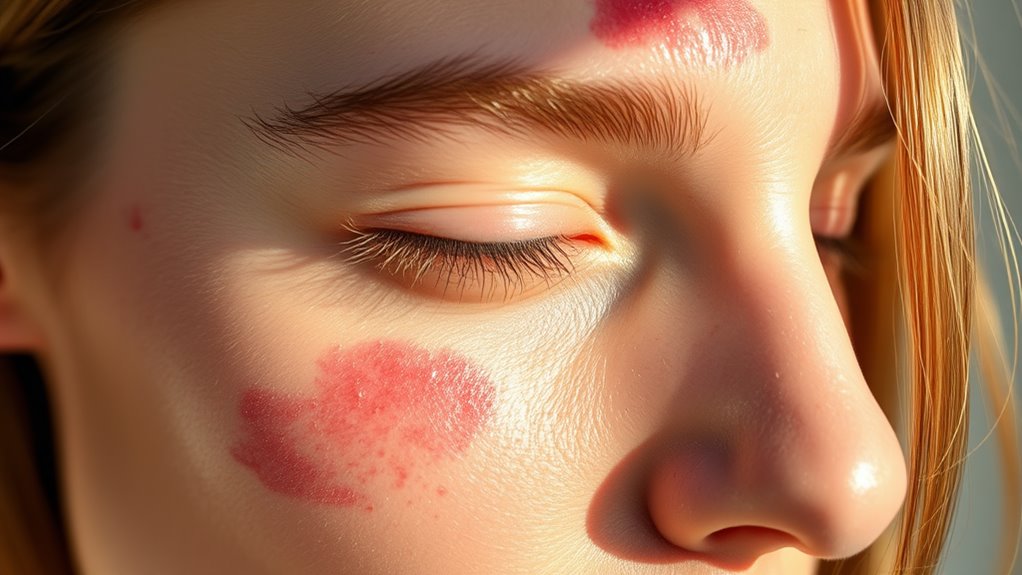Redness After Skincare. Here’s What Might Be Causing It
If you’re noticing redness after your skincare routine, it’s often due to irritating ingredients like alcohol, fragrances, or AHAs that disrupt your skin’s barrier and trigger inflammation. Environmental factors, such as UV exposure, pollution, or stress, can worsen it, while over-exfoliation, improper application, or allergic reactions might be culprits too. You’ll uncover effective ways to soothe and prevent this irritation in the details ahead.
Key Takeaways
- Ingredients like alcohol, fragrances, and AHAs can irritate the skin, causing redness and inflammation.
- Allergic reactions to preservatives or fragrances may lead to persistent redness, swelling, or itching.
- Environmental factors, such as UV radiation or pollution, can damage skin cells and trigger redness.
- Improper application order or excessive product use can disrupt the skin barrier, resulting in irritation.
- Over-exfoliation strips the protective layer, leading to dryness, inflammation, and redness.
Common Ingredients Causing Skin Redness
If you’ve ever noticed your skin turning red after applying a new product, it’s often because common ingredients like alcohol, fragrances, or alpha hydroxy acids (AHAs) irritate the skin’s barrier.
These substances disrupt the protective lipid layer, leading to post-skincare irritation where your skin reacts with inflammation and redness. For instance, alcohol dries out the epidermis, stripping away natural oils and triggering an inflammatory response.
Fragrances, even in small amounts, can provoke allergic reactions in sensitive individuals, causing blood vessels to dilate. AHAs exfoliate too aggressively, compromising the barrier and allowing irritants to penetrate deeper.
You can minimize this by checking labels and opting for hypoallergenic alternatives, as understanding these mechanisms empowers you to select safer products. Additionally, adopting soothing routines can help prevent irritation and promote long-term skin comfort.
Always patch-test new items to prevent unnecessary flare-ups, ensuring your routine supports skin health without unintended consequences.
Moreover, environmental factors like pollution or weather conditions can exacerbate skin irritation, making it essential to consider external influences in your skincare routine.
Environmental Triggers for Irritation
Beyond product ingredients, environmental factors like pollution, UV radiation, and extreme weather can trigger skin irritation and redness.
You encounter pollution daily, where airborne particles penetrate your skin’s barrier, sparking inflammation and oxidative stress that exacerbate redness.
UV radiation directly damages your skin cells; it activates enzymes that break down collagen and triggers an inflammatory response, heightening sensitivity.
Extreme weather plays a role too—intense heat dries out your skin, while cold winds strip away natural oils, leaving it vulnerable to irritation.
To minimize these effects, you should limit outdoor exposure during peak pollution or UV hours and use protective clothing. Moreover, incorporating stress management techniques can help mitigate inflammation and support overall skin health.
Additionally, chronic stress can worsen skin redness by amplifying inflammation and other skin symptoms.
Improper Application Techniques
When you apply skincare products, using the wrong order can disrupt your skin’s barrier and lead to irritation.
You also risk redness by applying excessive amounts, which overwhelms the skin and hinders absorption.
Understanding these techniques helps you minimize such reactions and maintain healthier skin. By avoiding common mistakes, you can achieve lasting results in your skincare routine.
Embracing actionable tips from reliable sources can further enhance your routine and promote overall skin health.
Wrong Application Order
One common mistake in skincare routines, such as applying products in the wrong order, can trigger redness and irritation on your skin. This disrupts the skin’s natural barrier, as products fail to absorb properly when layered incorrectly.
For example, applying a thick moisturizer before a lightweight serum creates a barrier that traps the serum on the surface, leading to buildup and inflammation. Scientifically, the stratum corneum relies on sequential application for optimal penetration; misordering can cause chemical interactions that irritate sensitive areas.
To avoid this, start with water-based products like toners and serums, then progress to oil-based ones like creams. This sequence ensures each layer sinks in effectively, reducing the likelihood of redness.
Excessive Product Amount
Another common error in skincare routines, such as applying excessive amounts of products, can overwhelm your skin’s barrier and spark redness or irritation.
This occurs because your skin absorbs only what it needs; excess creates a buildup that disrupts the barrier, triggering inflammation and sensitivity.
To avoid this, follow these guidelines:
-
Assess product needs: Determine the appropriate amount based on your skin type—oily skin tolerates less, while dry skin might need more, but always start minimal.
-
Measure precisely: Use guidelines like a pea-sized amount for cleansers or a nickel-sized dollop for moisturizers to prevent overloading.
-
Monitor absorption: Apply in thin layers and wait; if it doesn’t fully absorb, you’ve used too much, leading to potential irritation.
-
Adjust based on response: Track how your skin reacts and reduce quantities if you notice persistent redness, promoting a healthier barrier over time.
Over-Exfoliation and Its Effects
Exfoliating too frequently strips away your skin’s protective barrier, causing irritation that manifests as redness and sensitivity.
Over time, this disrupts the stratum corneum, the outermost layer responsible for moisture retention and defense against environmental stressors. You remove essential lipids and natural oils, leading to transepidermal water loss, dryness, and heightened vulnerability to inflammation.
Scientifically, excessive exfoliation—whether mechanical or chemical—alters the skin’s pH balance, promoting microbial overgrowth and triggering pro-inflammatory responses that worsen redness. This can result in micro-tears, prolonged sensitivity, and a cycle of irritation if not addressed.
To maintain skin health, you should limit sessions to once or twice weekly, choosing products suited to your skin type and allowing recovery periods for barrier repair. Monitoring your skin’s reactions ensures you avoid these adverse effects. Incorporating soothing products into your routine can help alleviate irritation and restore a balanced complexion.
Moreover, over-exfoliation can parallel the moisture balance disruptions caused by overwashing, as it may affect skin health and lead to potential breakout triggers.
Allergic Reactions in Skincare Routines
Allergic reactions to ingredients in your skincare products can trigger redness and inflammation, much like the sensitivity from over-exfoliation. Additionally, protecting your skin barrier involves avoiding common skincare mistakes to maintain its integrity.
These responses happen when your immune system overreacts to allergens, causing contact dermatitis or hives. It’s crucial to recognize these as distinct from irritation, as they’re immune-mediated.
To better understand potential triggers, consider these key factors:
-
Common allergens: Fragrances and preservatives like parabens frequently cause reactions by binding to skin proteins.
-
Symptom patterns: You might notice persistent itching, swelling, or blistering shortly after application, signaling an allergic response.
-
Patch testing: Dermatologists recommend it to identify specific culprits, helping you pinpoint problematic ingredients.
-
Cross-reactivity: Some allergens, like nickel or certain botanicals, can interact with multiple products, amplifying effects.
For quick relief from these reactions, explore natural remedies like soothing techniques to calm irritated skin.
Strategies to Soothe and Prevent Redness
You can effectively soothe redness after skincare by incorporating cooling techniques, such as applying a cold compress to calm inflamed areas. This can be enhanced by using soothing remedies to restore your skin’s natural balance.
Next, prioritize hydrating applications like gentle moisturizers to restore your skin’s barrier and lock in moisture.
Finally, avoid irritants by selecting non-comedogenic products, helping you prevent future flare-ups and maintain a balanced routine.
Moreover, leverage natural remedies from your kitchen, such as common ingredients, to further alleviate skin irritation and inflammation.
Cooling Techniques
While redness often follows aggressive skincare routines, cooling techniques provide immediate relief by constricting blood vessels and reducing inflammation.
You can integrate these methods into your daily regimen to calm irritated skin effectively. By lowering skin temperature, you minimize swelling and promote faster recovery without aggravating the issue.
Here are four effective cooling techniques to try:
-
Apply a cold compress****: Place a chilled cloth on affected areas for 5-10 minutes; it rapidly constricts vessels and eases discomfort.
-
Use ice packs****: Wrap ice in a soft towel and gently press it against red spots; this reduces inflammation by numbing the skin and limiting blood flow.
-
Employ a cooling fan****: Direct a fan at your face post-routine; the airflow accelerates evaporation, lowering temperature and soothing sensitivity.
-
Try refrigerated tools: Store a jade roller in the fridge and roll it over your skin; it delivers targeted cold therapy to alleviate persistent redness.
Hydrating Applications
Hydrating applications play a key role in soothing and preventing redness by restoring the skin’s moisture barrier, which helps reduce irritation and supports recovery from aggressive routines.
You can choose products with hyaluronic acid or ceramides to draw in and lock moisture, minimizing inflammation. For instance, apply a gentle, fragrance-free moisturizer twice daily—morning and night—to maintain hydration levels. This strengthens your skin’s barrier, making it less prone to flare-ups.
If you notice dryness, opt for occlusive options like petrolatum-based ointments, which seal in moisture effectively. Always patch-test new products to ensure compatibility, allowing your skin to heal and thrive with consistent care.
Irritant Avoidance
Irritants often exacerbate skin redness by disrupting the barrier, so identifying and avoiding them forms a cornerstone of effective prevention.
You can protect your skin by recognizing and eliminating these triggers, which helps restore balance and reduce inflammation.
To effectively avoid irritants, follow these steps:
-
Identify common culprits: Scan for ingredients like fragrances, alcohol, or sulfates in your products, as they can strip the skin’s natural oils.
-
Patch test regularly: Apply new skincare items to a small area first and wait 24-48 hours to check for reactions, preventing widespread irritation.
-
Opt for gentle alternatives: Choose non-comedogenic, pH-balanced formulas that minimize harsh chemicals and support your skin’s barrier.
-
Maintain a simplified routine: Limit product use to essentials and rotate items seasonally to avoid buildup of potential irritants.

